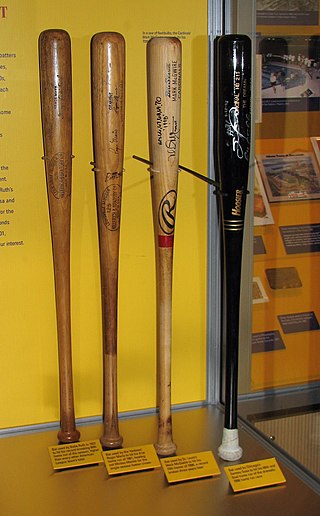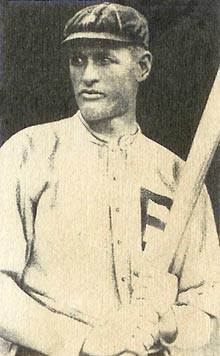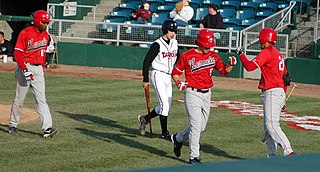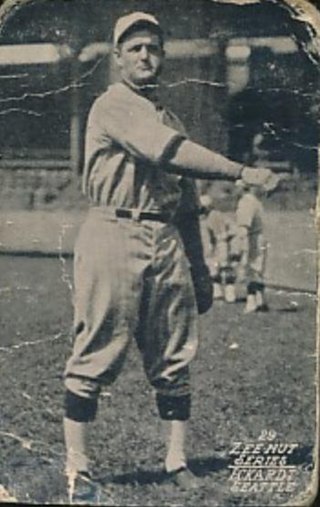Related Research Articles
In baseball, a sacrifice fly is defined by Rule 9.08(d): "Score a sacrifice fly when, before two are out, the batter hits a ball in flight handled by an outfielder or an infielder running in the outfield in fair or foul territory that
- is caught, and a run scores after the catch, or
- is dropped, and a runner scores, if in the scorer's judgment the runner could have scored after the catch had the fly ball been caught."
In baseball, a corked bat is a specially modified baseball bat that has been filled with cork or other lighter, less dense substances to make the bat lighter. A lighter bat gives a hitter a quicker swing and may improve the hitter's timing. Despite popular belief that corking a bat creates a "trampoline effect" causing a batted ball to travel farther, physics researchers have shown that this is not the case. In Major League Baseball, modifying a bat with foreign substances and using it in play is illegal and subject to ejection and further punishment.

William Henry Keeler, nicknamed "Wee Willie" because of his small stature, was an American right fielder in Major League Baseball who played from 1892 to 1910, primarily for the Baltimore Orioles and Brooklyn Superbas in the National League, and the New York Highlanders in the American League. Keeler, one of the best hitters of his time, was elected to the National Baseball Hall of Fame in 1939. One of the greatest contact hitters of all time and notoriously hard to strike out, Keeler has the highest career at bats-per-strikeout ratio in MLB history: throughout his career, on average he went more than 60 at bats between individual strikeouts.

A cricket bat is a specialised piece of equipment used by batters in the sport of cricket to hit the ball, typically consisting of a cane handle attached to a flat-fronted willow-wood blade. It may also be used by a batter who is making batter's ground to avoid a run out, by holding the bat and touching the ground with it. The length of the bat may be no more than 38 inches and the width no more than 4.25 inches. Its use is first mentioned in 1624. Since 1979, a law change has provided that cricket bats can only be made from wood.

A baseball bat is a smooth wooden or metal club used in the sport of baseball to hit the ball after it is thrown by the pitcher. By regulation it may be no more than 2.75 inches (7.0 cm) in diameter at the thickest part and no more than 42 inches (1.067 m) in length. Although historically bats approaching 3 pounds (1.4 kg) were swung, today bats of 33 ounces (0.94 kg) are common, topping out at 34 to 36 ounces.

Frederick "Cy" Williams was an American professional baseball player. He played in Major League Baseball as an outfielder for the Chicago Cubs (1912–17) and Philadelphia Phillies (1918–30). As Major League Baseball emerged from the dead-ball era, Williams became one of the most prominent home run hitters in the National League.

In baseball, batting is the act of facing the opposing pitcher and trying to produce offense for one's team. A batter or hitter is a person whose turn it is to face the pitcher. The three main goals of batters are to become a baserunner, to drive runners home or to advance runners along the bases for others to drive home, but the techniques and strategies they use to do so vary. Hitting uses a motion that is virtually unique to baseball and its fellow bat-and-ball sports, one that is rarely used in other sports. Hitting is unique because it involves rotating in the horizontal plane of movement, unlike most sports movements which occur in the vertical plane.

Hillerich & Bradsby Company (H&B) is an American manufacturing company located in Louisville, Kentucky that produces baseball bats for Wilson Sporting Goods, which commercializes them under the "Louisville Slugger" brand.

William James "Gates" Brown was an American Major League Baseball left fielder who spent his entire career with the Detroit Tigers (1963–1975). He batted left-handed and threw right-handed.

In baseball, a batboy or batgirl is an individual who carries baseball bats to the players on a baseball team. Duties of a batboy may also include handling and preparing players’ equipment and bringing baseballs to the umpire during the game. During games, a batboy remains in or near a team's dugout and the area around home plate.

Acer is a genus of trees and shrubs commonly known as maples. The genus is placed in the family Sapindaceae. There are approximately 132 species, most of which are native to Asia, with a number also appearing in Europe, northern Africa, and North America. Only one species, Acer laurinum, extends to the Southern Hemisphere. The type species of the genus is the sycamore maple, Acer pseudoplatanus, the most common maple species in Europe. Maples usually have easily recognizable palmate leaves and distinctive winged fruits. The closest relatives of the maples are the horse chestnuts. Maple syrup is made from the sap of some maple species. It is one of the most common genera of trees in Asia. Numerous maple species are widely grown in gardens where many are especially valued for their autumn colour.

Oscar George "Ox" Eckhardt was an outfielder for the Boston Braves and Brooklyn Dodgers. Eckhardt holds the known all-time professional baseball record for batting average, counting both major and minor league stats: .365.
David Leonard Roberts was a Panamanian Major League Baseball first baseman who played 22 seasons of professional baseball. Of all professional baseball players whose careers began in 1952 only Hank Aaron had a longer career. Born in Panama City, he threw and batted left-handed, stood 6 feet (1.8 m) tall and weighed 172 pounds (78 kg).

In baseball, batting average (BA) is determined by dividing a player's hits by their total at-bats. It is usually rounded to three decimal places and read without the decimal: A player with a batting average of .300 is "batting three-hundred". If necessary to break ties, batting averages could be taken beyond the .001 measurement. In this context, .001 is considered a "point", such that a .235 batter is 5 points higher than a .230 batter.
Batting average is a statistic in cricket, baseball, and softball that measures the performance of batters. The development of the baseball statistic was influenced by the cricket statistic.
Composite baseball bats, opposed to aluminum or wood baseball bats, incorporate a reinforced carbon fiber polymer, or composite, into the bat's construction. This composite material can make up all or part of the bat. Bats made entirely of this polymer are referred to as composite bats. Bats which only incorporate a portion of polymer are referred to as composite hybr Composite bats can also be constructed to improve their trampoline effect over time. That advantage, namely the improved trampoline effect over a break in period, put the use of composite bats under further NCAA scrutiny during the 2009 NCAA Division I baseball tournament. Composite bats, tested after they were already broke in, showed performance standards well beyond the accepted ball exit speed ratio (BESR) Test.
William Barrett was a professional baseball player from 1871 to 1873. He was born in either Baltimore or Washington, D.C., and played parts of three seasons in the National Association of Professional Base Ball Players, including at least one game with each of the Fort Wayne Kekiongas (1871), Washington Olympics (1872), and Baltimore Canaries (1873). According to records of The Sporting News, he also played during the 1872 season for the Brooklyn Atlantics. According to Baseball-Reference.com, he made his debut on July 8, 1871, and was the 102nd person to compete in the National Association. He also played at least three games with the Pastime Club of Baltimore during the 1871 season. He played as a catcher, third baseman, shortstop, and outfielder. He recorded a single, a double, a run batted in, and scored a run in 13 major league at bats.

EvoShield is an American brand that specializes in protective gear. Some of EvoShield products are wrist guards, elbow guards, as well as rib and heart protectors for the sports of baseball, gridiron football, lacrosse and softball.

Sam Bat, officially The Original Maple Bat Corporation, is a Canadian company based in the town of Carleton Place, Ontario that manufactures baseball bats. It was the first company to supply baseball bats manufactured from maple wood to professional baseball players. As of 2013, it is one of 32 licensed baseball bat suppliers for Major League Baseball (MLB) and Minor League Baseball (MiLB) players. It is also a bat supplier for baseball leagues throughout the world, including Germany, Japan, Korea, Italy, Mexico, and the Netherlands. It is the official bat manufacturer for the Australian Baseball League.
References
- 1 2 "Why baseball players 'bone' their bats". Popular Science. May 20, 2020. Retrieved April 19, 2021.
- 1 2 3 Jorge Castillo (May 31, 2017). "Why do the Nationals have a 38-year-old cow femur and what is bat boning?". Washington Post (via Tri-County Independent). Retrieved April 19, 2021.
- ↑ "Science of Baseball: Tools of the Trade". Exploratorium. Retrieved April 19, 2021.
- 1 2 Doug Bernier (June 7, 2012). "How to Bone a Bat" . Retrieved April 19, 2021.
- 1 2 "How Big-League Bats Are Getting Harder Than Ever" . Wired. September 26, 2012. Retrieved April 19, 2021.
- 1 2 3 Ben Walker (Summer 2010). "Properties of Baseball Bats". Baseball Research Journal. SABR (Society for American Baseball Research). Retrieved April 24, 2021.
- ↑ Malamud, Bernard (1952). The Natural. Harcourt Brace and Company. ISBN 9785557117104.
- ↑ Jaime Cárdenas (August 24, 2005). "Make no bones about it". [Spokane] Spokesman-Review. Retrieved April 19, 2021.
- ↑ Larry Stone (September 23, 2008). "The Art of Baseball: Bat Talk". Seattle Times. Retrieved April 19, 2021.
- ↑ Millard Fisher (Fall 2009). "James Lanier: Ty Cobb's Batboy". Baseball Research Journal. SABR (Society for American Baseball Research). Retrieved April 19, 2021.
- ↑ "Lot #200: 1952 New York Yankees Batboy Boning Cliff Maples [sic] Baseball Bat". Mears Monthly Auctions. 2014. Retrieved April 19, 2021.